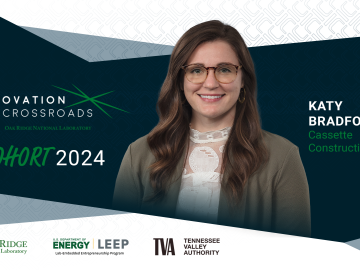
Filter News
Area of Research
- Advanced Manufacturing (14)
- Biology and Environment (40)
- Biology and Soft Matter (1)
- Building Technologies (1)
- Clean Energy (69)
- Climate and Environmental Systems (2)
- Computational Engineering (1)
- Fusion and Fission (6)
- Fusion Energy (2)
- Isotopes (20)
- Materials (23)
- Materials for Computing (3)
- Mathematics (1)
- National Security (14)
- Neutron Science (5)
- Nuclear Science and Technology (7)
- Quantum information Science (1)
- Supercomputing (32)
News Type
News Topics
- (-) 3-D Printing/Advanced Manufacturing (78)
- (-) Climate Change (81)
- (-) Cybersecurity (17)
- (-) Frontier (28)
- (-) Isotopes (37)
- (-) Partnerships (22)
- (-) Renewable Energy (1)
- (-) Space Exploration (22)
- Advanced Reactors (22)
- Artificial Intelligence (66)
- Big Data (50)
- Bioenergy (68)
- Biology (79)
- Biomedical (43)
- Biotechnology (16)
- Buildings (48)
- Chemical Sciences (40)
- Clean Water (29)
- Composites (18)
- Computer Science (134)
- Coronavirus (29)
- Critical Materials (18)
- Decarbonization (62)
- Education (2)
- Emergency (2)
- Energy Storage (67)
- Environment (157)
- Exascale Computing (30)
- Fossil Energy (5)
- Fusion (42)
- Grid (49)
- High-Performance Computing (59)
- Hydropower (11)
- Irradiation (2)
- ITER (5)
- Machine Learning (37)
- Materials (80)
- Materials Science (90)
- Mathematics (10)
- Mercury (10)
- Microelectronics (3)
- Microscopy (34)
- Molten Salt (6)
- Nanotechnology (32)
- National Security (52)
- Net Zero (10)
- Neutron Science (81)
- Nuclear Energy (80)
- Physics (40)
- Polymers (20)
- Quantum Computing (26)
- Quantum Science (43)
- Security (14)
- Simulation (41)
- Software (1)
- Statistics (2)
- Summit (37)
- Sustainable Energy (96)
- Transformational Challenge Reactor (3)
- Transportation (68)
Media Contacts

Daryl Yang is coupling his science and engineering expertise to devise new ways to measure significant changes going on in the Arctic, a region that’s warming nearly four times faster than other parts of the planet. The remote sensing technologies and modeling tools he develops and leverages for the Next-Generation Ecosystem Experiments in the Arctic project, or NGEE Arctic, help improve models of the ecosystem to better inform decision-making as the landscape changes.

Katy Bradford is on a mission to revolutionize the construction industry and is the founder of Cassette Construction, a company in the newest cohort of Innovation Crossroads, a DOE Lab-Embedded Entrepreneurship Program node at ORNL. As an Innovation Crossroads fellow, Bradford and her company will receive technical, financial and networking support to successfully advance the company’s products to the marketplace.
After retiring from Y-12, Scott Abston joined the Isotope Science and Engineering Directorate to support isotope production and work with his former manager. He now leads a team maintaining critical equipment for medical and space applications. Abston finds fulfillment in mentoring his team and is pleased with his decision to continue working.

Scientists using high-resolution aerial scans and computational modeling concluded that wildfires, storms and selective logging have become key drivers behind rainforest carbon emissions, outpacing clear-cutting practices.

A new convergent manufacturing platform, developed in only five months at the Department of Energy’s Oak Ridge National Laboratory, is debuting at the International Manufacturing Technology Show, or IMTS, in Chicago, Sept. 9–12, 2024.

As a mechanical engineer in building envelope materials research at ORNL, Bryan Maldonado sees opportunities to apply his scientific expertise virtually everywhere he goes, from coast to coast. As an expert in understanding how complex systems operate, he’s using machine learning methods to control the process and ultimately optimize performance.

Nuclear physicists at the Department of Energy’s Oak Ridge National Laboratory recently used Frontier, the world’s most powerful supercomputer, to calculate the magnetic properties of calcium-48’s atomic nucleus.

ORNL’s Joshua New was named the 2024 Researcher of the Year by R&D World magazine as part of its R&D 100 Professional Award winners.

Jeremiah Sewell leads a team at ORNL, working on xenon-129 production for lung imaging. Reflecting on his career, Sewell views each opportunity as a "door" he steps through, leveraging over 25 years of experience in nuclear power and centrifuge operations to advance the facility’s mission.

A study found that beaches with manmade fortifications recover more slowly from hurricanes than natural beaches, losing more sand and vegetation. The researchers used satellite images and light detection and ranging data, or LIDAR, to measure elevation changes and vegetation coverage. Changes in elevation showed how much sand was depleted during the storm and how much sand returned throughout the following year.


